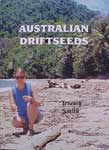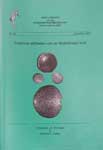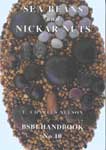| WWW.SEABEAN.COM HOME PAGE | MAIN How To Page |
How to Care for Sea-Beans
![]()
See also: How to Collect Sea-Beans
|
Now what? 1. Wash those sea-beans! Sea-beans will have a bit of salt on them, either from the salt water, the salt spray, or salts in the sands on the beach. Salt is hygroscopic... i.e., it will pull water out of the air. That's why people put rice into salt shakers... the rice absorbs the water, keeping the salt dry. Well, salt on the sea-beans will attract water out of the air, and that's a bad thing because your sea-beans will tend to be wet (or moist) all the time. When you get home with your sea-beans, dump them into a bucket/bowl of warm fresh water. Let them soak for awhile; this will disolve and dilute the salt. Dump the somewhat salty water outside... there's likely to be a bunch of sand in the bowl too! You don't want salt or sand in your house pipes! Rinse the sea-beans again in warm fresh water. After a bit of a soak, remove them, pat them dry with a towel and let them air dry. 2. Freeze those beans! If your new found sea-beans have been on the beach for awhile, they may have been "infected" with bugs or beetles. If this has happened, you may have a hatch of insects not too long (or even months!) after arriving home with your sea-beans. This situation may be even more prevalent if you've collected the seeds prior to floating and beach stranding... i.e., you've collected them directly from the live plants or forest/jungle floor! One way to combat this is to freeze your seeds for several weeks! Don't think that just a few or several days will do the trick... it won't! The longer, the better, for sure. Also the colder, the better: if you've got a "deep freezer", use that vs your standard freezer in your refrigerator. Stories confirm that this is insufficient. This is most important if you are making sea-bean jewelry... you don't want someone's sea-bean necklace to "hatch" at dinner!!! At home, in storage, you don't want a hatch of insects that will then mate and lay additional eggs in your previously intact sea-beans. The bugs will eat your seeds, from the inside out! It has also been suggested to purchase some bug killer spray (not just repellent... killer!) and spray this into a plastic bag containing your sea-beans. Seal the bag immediately and wait a day or so, and that should do it! That said, don't freeze those seeds that you are planning to plant and grow! 3. Write some labels! Write out some data labels stating the date and location that the sea-beans were found. This may be important, years from now, for the rare beans that take a long time to get identified. Finds of rare beans generate important distribution records. This increases the value of your collection to others and to science. Granted, you're not likely to add labels to all your sea-beans, but please do it for the rare and unidentified sea-beans! Add any important notes too: e.g. the date, what beach you found them on, any onshore winds, also found on same day/week by other beaners, etc. 4. Identify your sea-beans. Applying names to your sea-beans helps you to talk about them to others. Knowing their names then allows you to speculate on their origin and calculate how far they may have travelled or how much time it may have taken them to arrive. There are several books on sea-beans that are sure to be helpful. You can also post a digital picture to the membership of the SEABEAN-L listserve and/or the FaceBook Group: Seabeans, asking for help with identification.
5. Storage and Display. Initially, your beans should be kept where they can "breathe". They surely contain some water and may still have water on the outside of them (in cracks, crevices, ect.). Let them dry VERY well!!! If you place even minimally wet beans into closed, air-tight containers they will likely grow some mold, possibly destroying the beans. Eventually, closed containers can work for you. This may be plastic containers with tight-fitting lids, or perhaps appropriatley-sized ziptop bags. This works for those who want to have a good "reference collection" of correctly named (or unidentified) sea-beans. Then again, displays of sea-beans as crafts or simply loose in open top baskets or bowls work well too! Additionally, there are several educational public displays of sea-beans. Perhaps you could create one in your area!  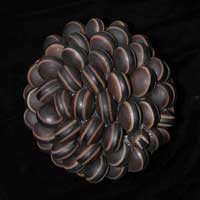 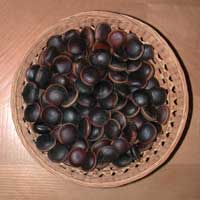
6. Share your "finds"! Let others know what you found, where your found it, and when. There are many people interested in who's finding what. Share your experience and "finds" via the FaceBook group "Sea Beans" or post more technical or scientific questions and findings via the SEABEAN-L listserve. Include some details regarding your travels to get to the collecting beach... chances are, there's a story there that's worth telling! Also, if you live in the USA, in the Melbourne area of the east coast of Florida, you may want to attend the periodic "Beaner's Night Out" where beaners (aka "Drifters") get together for a light dinner and heavy conversation about sea-beans! For more info about this irregularly scheduled event, contact Ed Perry at: |
||||||||||||||||
Links
Be sure to check out chapter 8, "Making a Collection" in Perry & Dennis: "Sea-Beans from the Tropics"
...when, where, how, cleaning and storing is discussed in greater detail.
